Every year, businesses lose millions due to theft, counterfeiting, and supply chain tampering. However, by using the right tamper-evident technologies and solutions—companies can prevent unauthorized access and significantly reduce the risk of product manipulation and fraud.
Among the best options available, security tapes provide an immediate warning against tampering. Here, we will cover different types of security tape, including full transfer, partial transfer, and non-transfer, and compare them to help you choose the best security tape for your needs.
What is Full Transfer Security Tape?
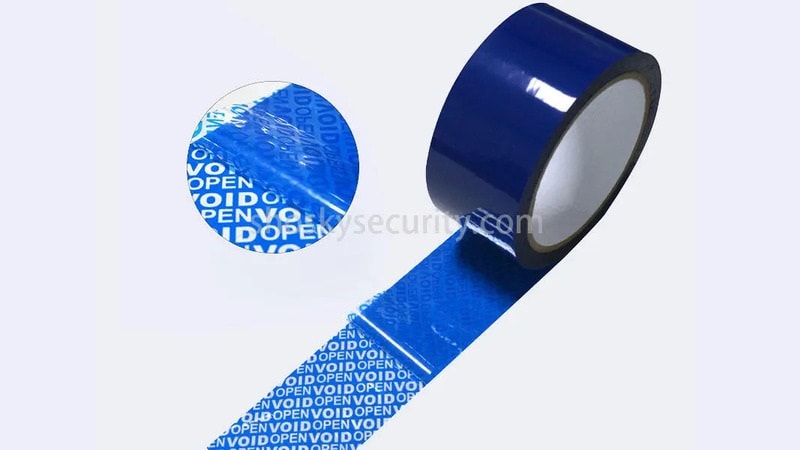
Full transfer security tape is a specialized security tape designed for maximum security. When removed, it transfers 100% of its adhesive layer to the protected surface, leaving an unmistakable “VOID” or custom message pattern. This complete transfer provides ironclad evidence of any security breaches.
Here is how it works: the full transfer security tape uses a unique three-layer system. The backing, the message layer, and the adhesive layer. Upon application, the adhesive creates a strong bond with both the surface and the message layer. When someone attempts to remove the tape, the powerful adhesive causes the message layer to separate completely from the backing, transferring the entire pattern to the surface below.
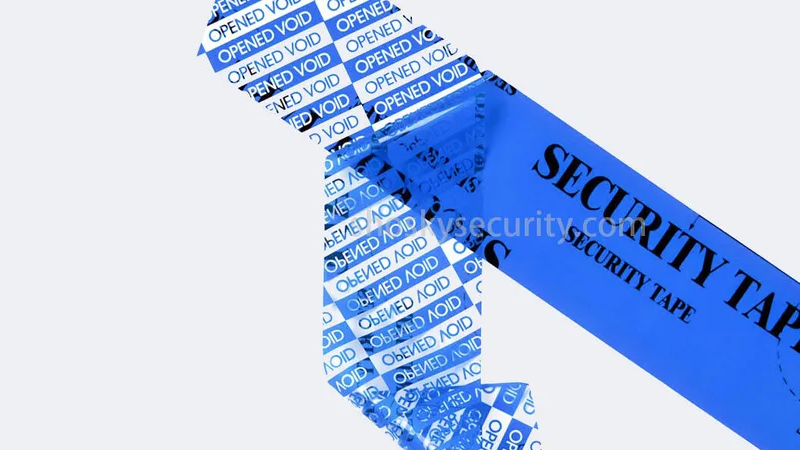
Full transfer security tape is ideal for securing shipments wrapped in heat shrink film or stretch wrap film, adding an extra layer of protection to prevent unauthorized access. Besides, the tape’s permanent transfer mechanism makes it ideal for:
- Pharmaceutical packaging and medicine bottle seals
- High-value electronics and warranty protection
- Banking and financial document security
- Government-classified document protection
- Evidence bags and forensic sealing
- High-security shipping container protection
What is Partial Transfer Security Tape?
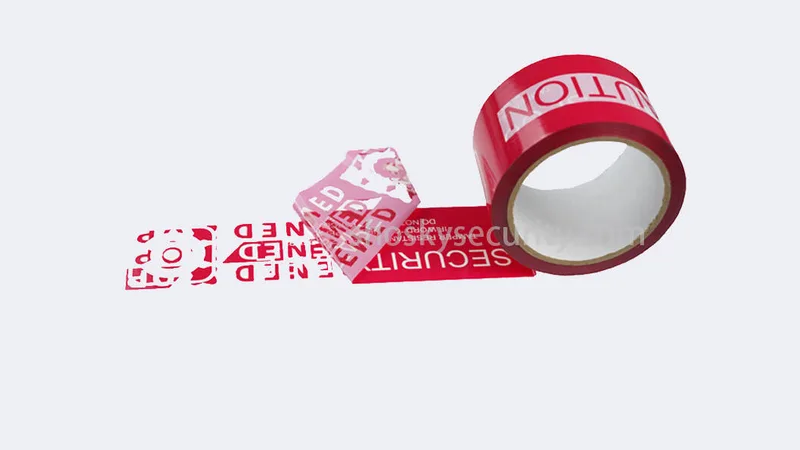
Partial transfer security tape offers a balanced security solution that leaves evidence of tampering on both the original surface and the removed tape. When peeled away, the adhesive splits between the surface and tape backing, creating distinctive patterns that clearly show interference while maintaining some adhesive properties for potential reapplication if needed.
Here is how it works: the partial transfer security tape employs a specialized split-adhesive technology that activates during removal attempts. As someone tries to peel the tape, the adhesive layer deliberately separates, leaving portions on both the protected surface and the tape backing. This splitting action creates clear visual evidence of tampering while preserving some of the tape’s original properties.

Partial transfer security tape serves markets where visible tamper evidence is crucial, but complete destruction isn’t necessary. Common applications of partial transfer security tape include:
- Sealing carton boxes, ballot boxes, and voting equipment
- Marking quality control inspections
- Providing temporary security for shipping containers
- Verifying equipment maintenance
- Managing inventory control systems
- Protecting document deliveries
What is a Non-Transfer Security Tape?
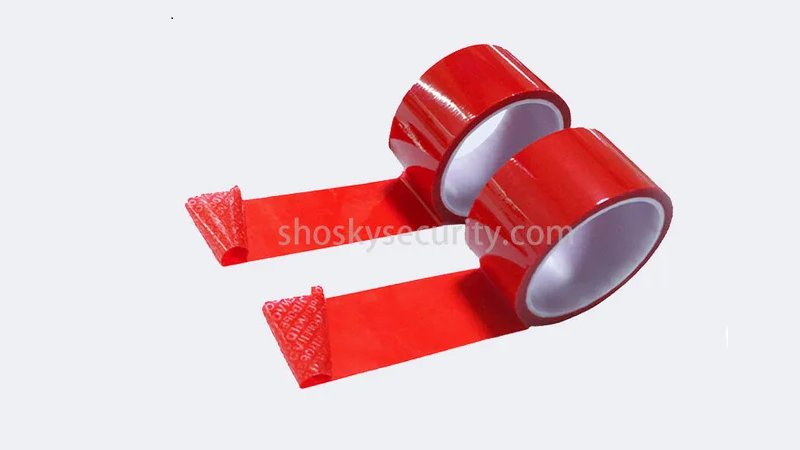
Non-transfer security tape reveals tampering through visible changes in its appearance and showing hidden messages without leaving adhesive residue on protected surfaces. This innovative solution provides clear evidence of interference while maintaining surface cleanliness, making it perfect for situations requiring regular security checks or multiple applications.
Here is how it works: the tape incorporates reactive coating that responds to tampering attempts through either mechanical stress or environmental exposure. When disturbed, these coatings undergo visible changes, creating obvious signs of tampering while allowing for clean removal when authorized. This mechanism provides security without compromising surface integrity.
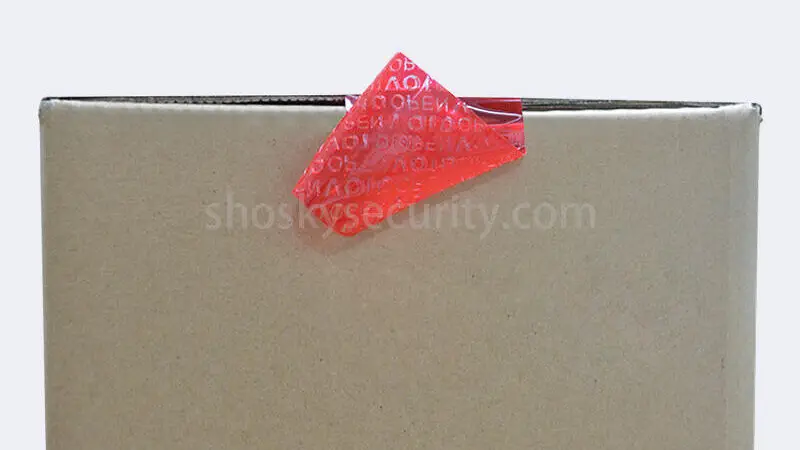
Non-transfer security tape excels in environments where cleanliness and repeated application are important. It’s commonly known in security markets for use in:
- Laboratory sample management
- Food production quality assurance
- Medical equipment sterilization verification
- Reusable container security
- Temperature-sensitive product monitoring
- Temporary security barriers and access control
Key Differences Between Full Transfer, Partial Transfer, and Non-Transfer Security Tapes

When choosing between the best possible tamper-proof security tape varieties, understanding their key differences is crucial for making the right choice for your specific needs. Let’s break down how these tapes compare across important factors:
| Feature | Full Transfer | Partial Transfer | Non-Transfer |
|---|---|---|---|
| Security Level | Highest | Moderate | Basic |
| Adhesive Transfer | 100% transfer to surface | Split between surface and tape | No transfer |
| Reusability | Not reusable | Partially reusable | Often reusable |
| Tamper Evidence | Permanent void message | Split pattern visible | Color/pattern change |
| Cost | Highest | Moderate | Most economical |
| Residue | Complete adhesive residue | Partial residue | Minimal to no residue |
| Application Type | Permanent | Semi-permanent | Temporary |
| Surface Impact | Significant | Moderate | Minimal |
| Environmental Resistance | Highest | Moderate | Varies |
| Visibility of Tampering | Most visible | Clearly visible | Visible but subtle |
How to Choose the Right Security Tape for Your Needs
Selecting the right security tape requires careful consideration of various factors. Below are the key aspects to evaluate when choosing the best option for your business or organization.
Security Level Required

The first thing is determining the level of security your application demands. The level of security needed varies dramatically across different industries and applications. High-stakes industries demand full transfer security tapes that provide unmistakable evidence of tampering through permanent void messages and complete adhesive transfer.
For moderate security needs, such as quality control seals or inventory management, partial transfer tapes offer a balanced solution. Consider whether you need features like serialization, custom void messages, or specific color indicators that align with your security protocols and tracking systems.
Surface Compatibility
Understanding the interaction between security tapes and different surface materials is crucial for maintaining effective security. Different tapes adhere better to specific surfaces.
Smooth materials such as plastic, glass, and metal allow most security tapes to form a strong bond. However, rough or porous surfaces like wood, fabric, or cardboard may require specialized adhesives to ensure effective security. Choosing the wrong tape for a particular surface can result in weak adhesion, making tampering easier.
For packaging or equipment that requires frequent access, the removal process should also be considered. If tape leaves excessive residue on delicate surfaces, it may cause damage or require extra cleaning, increasing operating costs. Ensuring compatibility with your intended surfaces helps maintain both security and practicality.
Environmental Conditions
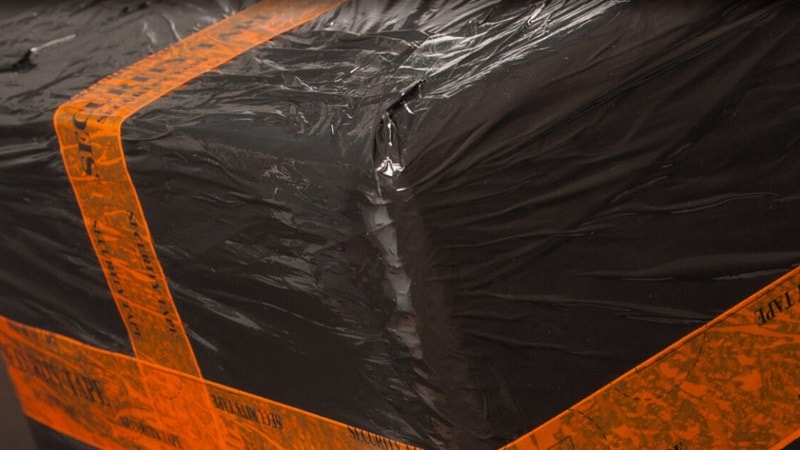
Environmental factors can significantly impact possible tamper-proof solutions’ performance and longevity. In temperature-controlled environments like warehouses or indoor facilities, standard security tapes often perform well. However, challenging conditions require specialized solutions that maintain their security features despite environmental stress.
Exposure to extreme conditions demands careful consideration of:
- Temperature resistance range (-40°C to +80°C typical range)
- Humidity and moisture exposure limits
- Ulta-violet radiation protection requirements
- Chemical exposure resistance
- Impact of seasonal weather changes
High-temperature environments, such as warehouses or transport vehicles exposed to heat, may require tapes that are heat-resistant to prevent adhesive failure. Similarly, cold storage facilities need tapes that maintain adhesion even in freezing conditions.
If the tape is used outdoors or in damp conditions, moisture and UV resistance are crucial. Waterproof security tapes prevent adhesive breakdown due to humidity or rain, while UV-resistant options ensure that prolonged sun exposure doesn’t weaken security features. Businesses should assess these factors based on their storage and transit environments.
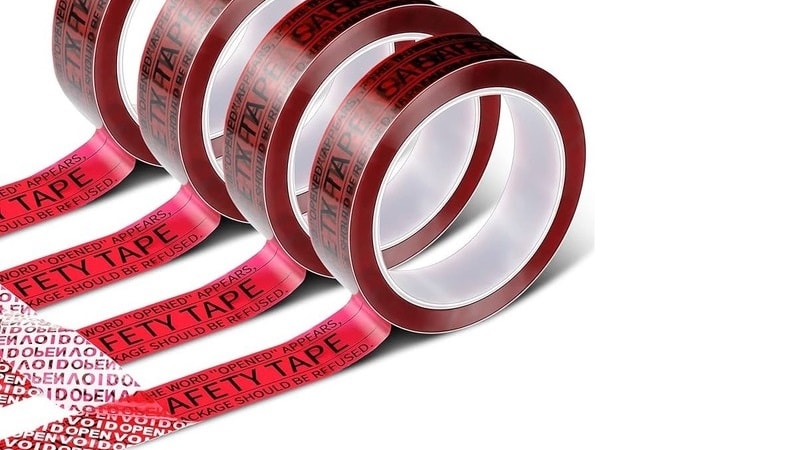
Duration of Application
The intended lifespan of your security seal directly influences and makes a difference when choosing the type of tape needed. Long-term applications, such as equipment warranty seals or permanent security barriers, benefit from full transfer tapes that provide lasting tamper evidence and cannot be repositioned or reused.
Short-term applications like temporary quality control seals or inspection markers might be better served by partial or non-transfer tapes. These options offer adequate security while allowing for clean removal and potential reapplication, making them more cost-effective for frequent change scenarios.
Industry Regulations & Compliance
Regulatory requirements often dictate specific security features and performance standards for tamper-evident seals and tamper-evident labels. In pharmaceutical packaging, for instance, tamper-proof solutions must meet FDA guidelines and provide clear evidence of tampering to protect consumer safety. Similarly, government agencies and financial institutions must use high-security tapes to protect confidential documents.
Businesses should check whether the security tape complies with relevant certifications, such as ISO, SGS, and RoHS standards. These certifications ensure that the tape meets international safety, environmental, and security regulations, making it suitable for industry-specific applications.

Cost Considerations
Security tapes vary in price based on material, adhesive strength, and security features. Transfer tamper evident security tape offers the highest level of security but may have a higher price tag compared to non-transfer or partial transfer tapes. While cost is a factor, choosing a tape that provides adequate security without excessive expense is key.
Beyond the initial purchase cost, businesses should also consider long-term expenses such as labor for application, replacement frequency, and potential cleaning or surface restoration after removal. A cost-effective solution balances security needs with practical usability and maintenance costs.
Key Questions to Ask Before Choosing a Security Tape
- What level of security does my industry require?
- What surfaces will the tape be applied to?
- Will the tape be exposed to extreme temperatures or moisture?
- How long does the tape need to stay in place?
- Does my business need to comply with specific security regulations?
- What is my budget for security tapes, including application and replacement costs?
By answering these questions and considering these factors, businesses can choose the most effective security tape for their needs, ensuring both protection and cost-efficiency.
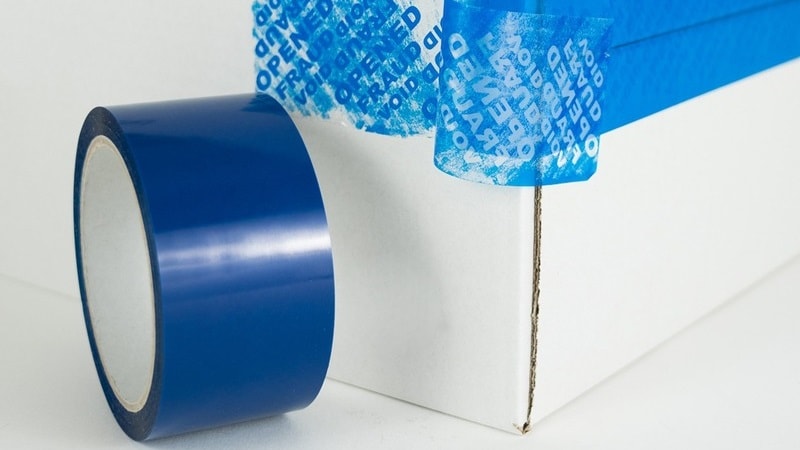
Benefits of Using Tamper-Evident Security Tapes
Tamper-evident security tapes help businesses detect and prevent unauthorized access, making them essential for protecting high-value and sensitive goods. They provide a visible sign of tampering, ensuring shipments, documents, and products remain secure.
These tapes also strengthen supply chain integrity by preventing theft and counterfeiting. Logistics and regulated industries rely on them to meet compliance standards and safeguard goods during storage and transit. Beyond security, they offer cost savings by reducing losses and liability risks. By deterring tampering from the start, businesses can avoid costly investigations and disputes over compromised shipments.
Best Practices for Using Security Tapes
To maximize protection, businesses should follow best practices when applying tamper-evident security tapes. Proper surface preparation is key—make sure the area is clean, dry, and free of dust or oils before applying the tape. This ensures strong adhesion and prevents easy removal or tampering.
Apply the tape with firm, even pressure, to create a secure bond. For full transfer and partial transfer tapes, avoid repositioning after application, as this may weaken the security effect. If sealing a box or package, cover all openings to prevent unauthorized access from any side.
Businesses should integrate security tapes into their existing security protocols for enhanced protection. Using security logs or digital tracking systems can help monitor when and where tapes are applied. Regular security checks can ensure that seals remain intact throughout storage and transport.
Choosing the right security tape for each application is also important. High-security shipments require full transfer tapes, while reusable containers may benefit from non-transfer options. By selecting the right tape and following best practices, organizations can strengthen security, reduce risks, and maintain compliance with industry standards.
FAQs
Is non-transfer security tape suitable for all packaging types?
Non-transfer security tape works best on smooth surfaces like plastic, glass, and metal but may not adhere well to rough or porous materials.
How long does the security tape stay intact after being applied?
The durability depends on the tape type and environmental conditions, but most high-quality security tapes remain effective for months or even years.
Are there environmentally friendly options for security tapes?
Yes, some security tapes use biodegradable materials or eco-friendly adhesives to reduce environmental impact without compromising security.
Conclusion
Tamper-evident security tapes provide an essential layer of protection for businesses. Whether used in logistics, retail, or high-security environments, these tapes play a critical role in securing goods from production to delivery. So, invest in the right tamper-evident tape and protect your product business and your brand integrity!
Guaranteed Protection
Shosky Security offers a comprehensive range of tamper-evident solutions, including full-transfer security tape, partial-transfer security tape, and non-transfer security tape. Contact us today to explore our tamper-evident solutions and take a proactive step in protecting your products, reputation, and bottom line.

